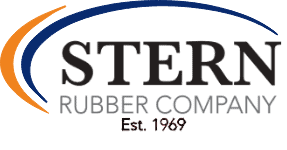Rubber transfer molding requires creating a raw mix or rubber compound that is cut and weighed, or made into “pre-forms”. Where transfer molding differs from compression molding is that the rubber is not put into the cavity of the mold and then compressed, rather, it is compressed and injected into the mold.
The Transfer Molding Process
Our transfer molding process involves these key steps:
Preparing the Mold and Material
Before the transfer molding process begins, it’s important to prepare the mold and rubber material. Transfer molds vary in shape and size and typically contain a high number of cavities, depending on the needs of the application. Once the mold is prepared, raw rubber materials are cut and weighed or made into pre-forms.
Loading the Rubber Material
Transfer molds contain a transfer pot and a ram. Once the raw materials are prepared, they are placed in the transfer pot located above the cavity area.
Applying Heat and Pressure
As the transfer mold closes, the ram compresses or pushes the compounded rubber materials through a sprue system into the cavity below. Utilizing heat and pressure, the rubber compound vulcanizes or cures, taking on the shape of the mold.
Hardening and Cooling
Once the rubber part cures, it is allowed to harden and cool inside the mold.
Ejecting the Finished Product
After the part has completely cooled, it is ejected from the mold. Any excess cured rubber, or flash, is trimmed and removed from the finished product.
Benefits of Transfer Molding in Rubber Manufacturing
Rubber transfer molding is an accurate and effective alternative to other molding techniques. Some of its benefits include:
Precision and Complexity
The process allows for much tighter tolerances, enabling it to produce more intricate or complex parts that may be difficult to achieve with compression molding. This level of precision ensures that all specific design requirements can be met while ensuring optimal quality.
Enhanced Product Quality and Consistency
The rubber transfer molding process is more consistent than compression molding. Because the mold is closed before the rubber is injected, parts are more dimensionally consistent across a production run. This level of consistency minimizes part variations and defects, resulting in enhanced performance and reliability.
Versatility and Flexibility
Rubber transfer molding offers versatility when it comes to material selection and product design. For example, the process allows for sharper edges and is also suitable for thin-walled parts as well as overmolding plastic or metal inserts. Because of its flexibility, rubber transfer molding can accommodate a diverse range of application requirements.
Time and Cost Savings
Transfer molding offers faster cycle times compared to compression molding, as you only have to cut one pre-form of rubber rather than cutting one pre-form of rubber per mold. Additionally, it can produce parts with minimal or no flash, reducing the need for time-consuming deflashing processes. This helps to streamline the manufacturing process, leading to reduced costs and greater production efficiency.
Rubber Transfer Molding by Stern Rubber
Rubber transfer molding offers numerous advantages that make it a popular choice for producing a wide range of products. At Stern Rubber, we’re a custom manufacturer of rubber molded products with over five decades of experience. Our rubber transfer molding expertise ensures we complete your project on time and on budget without compromising on quality.
For more information about our rubber transfer molding capabilities, or to get started on your next rubber molding project, contact us today.
